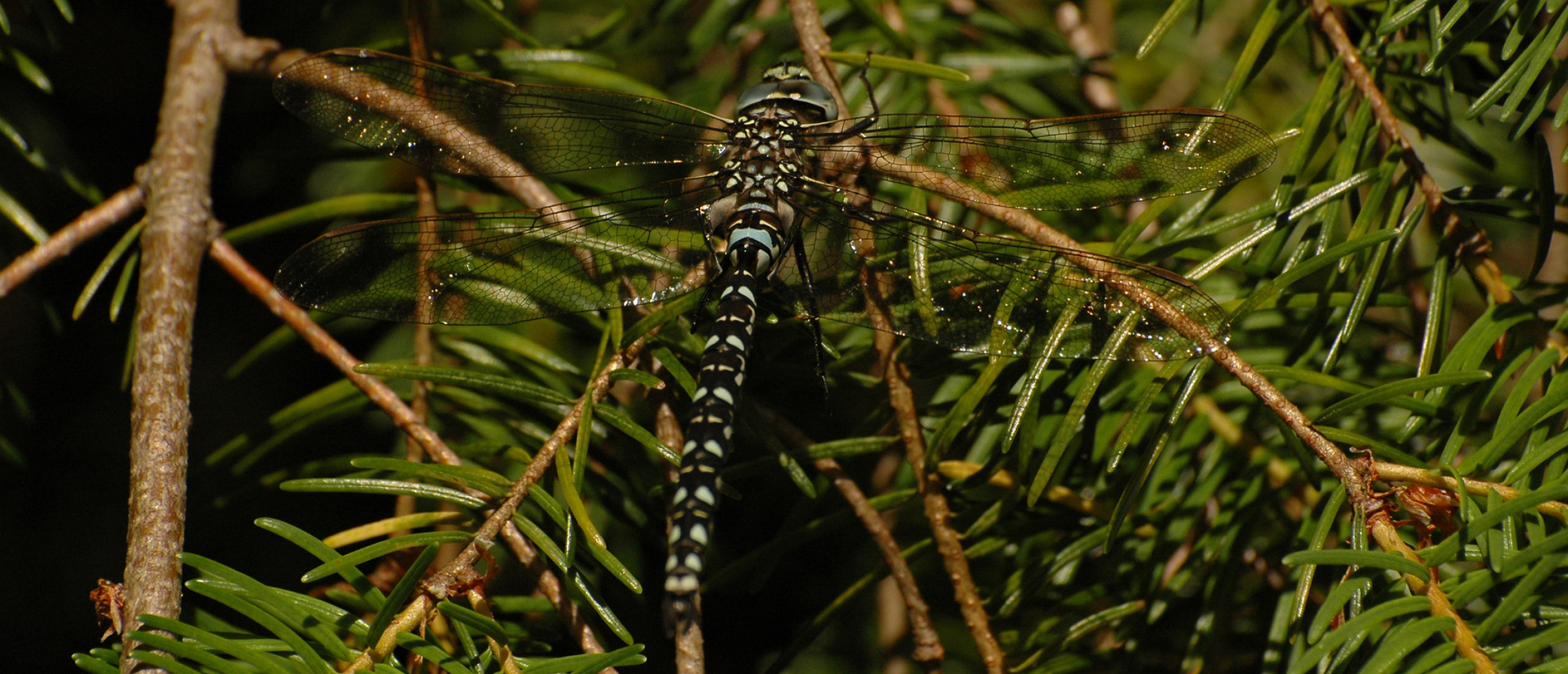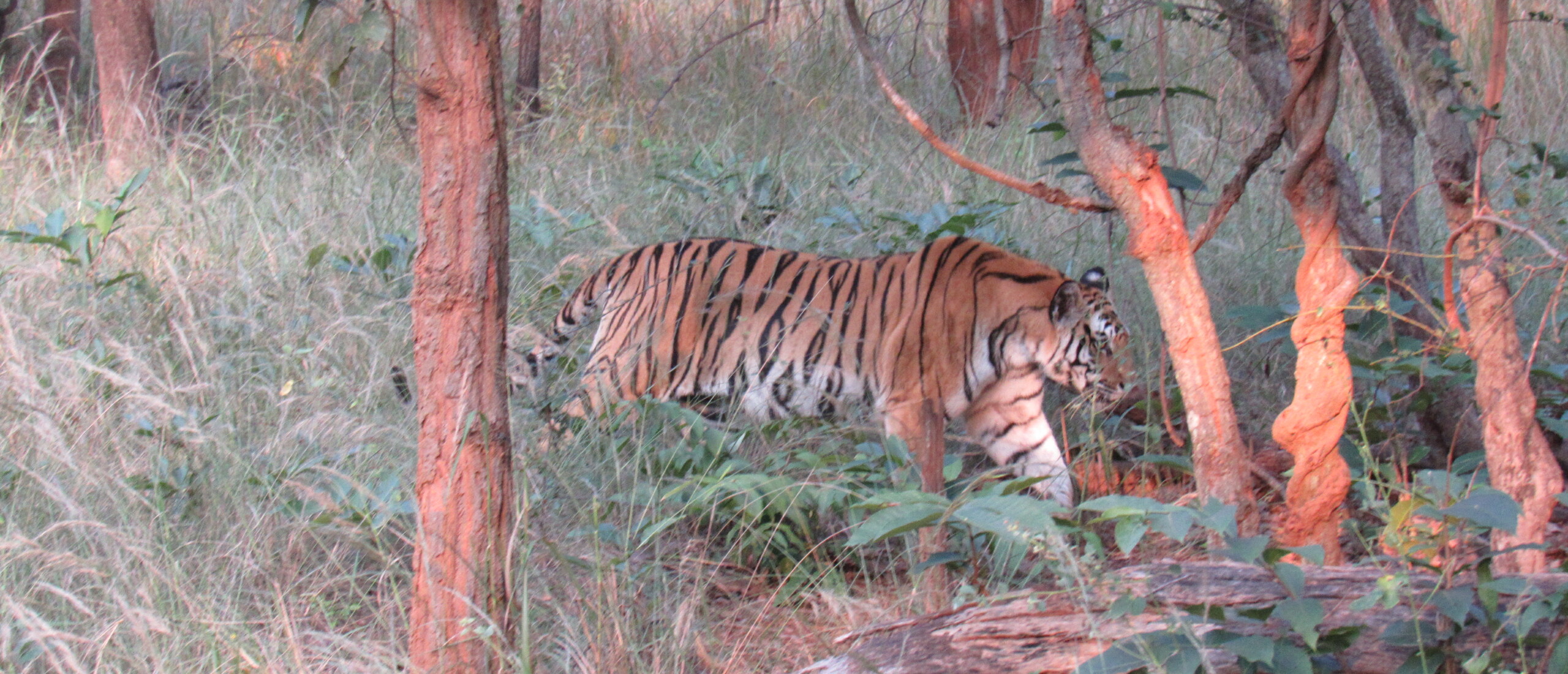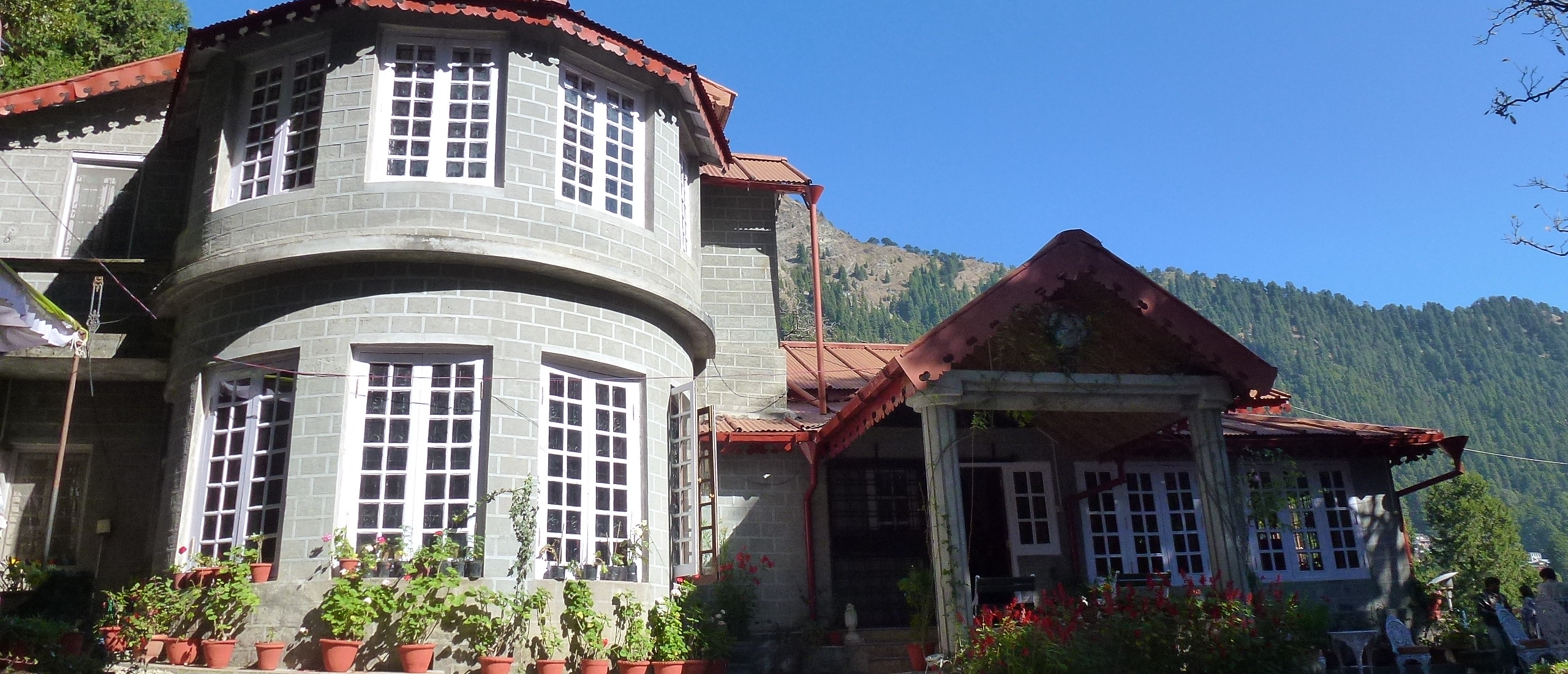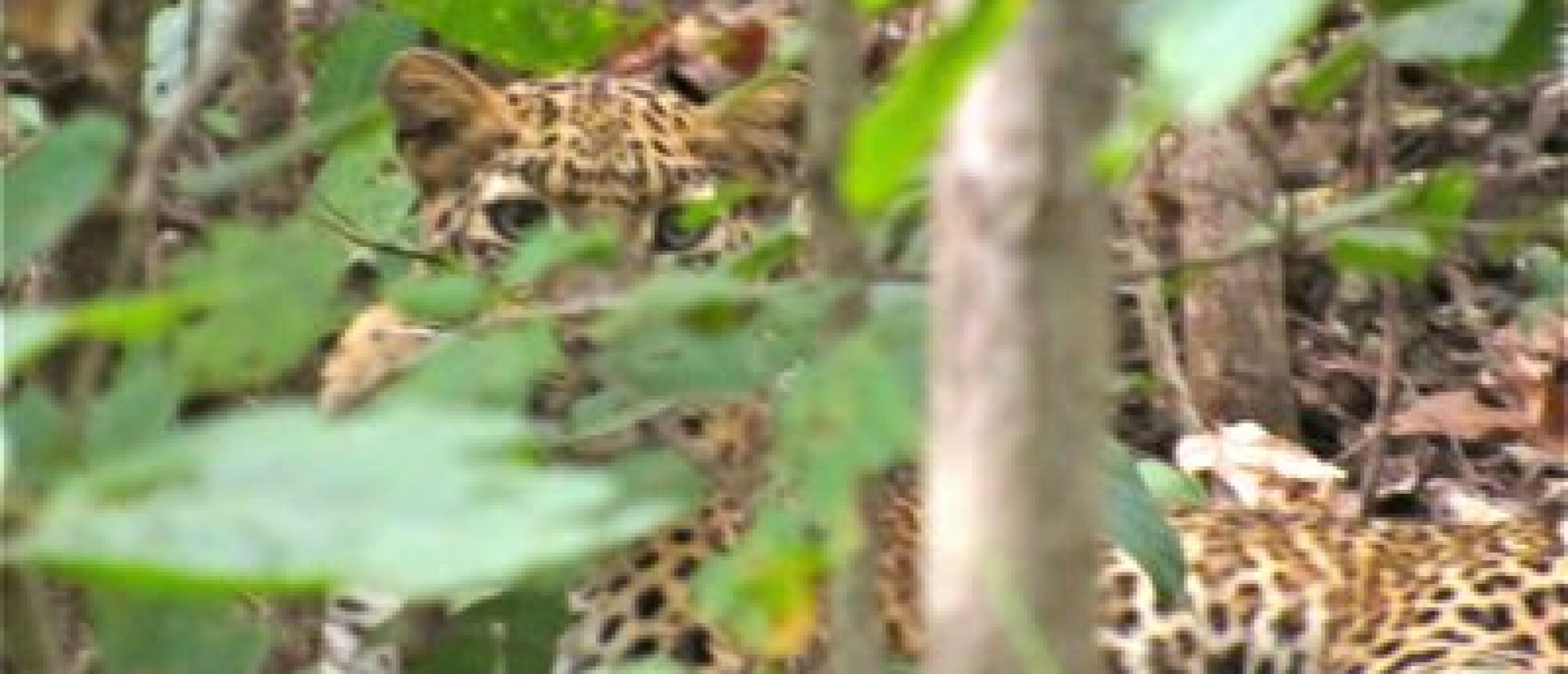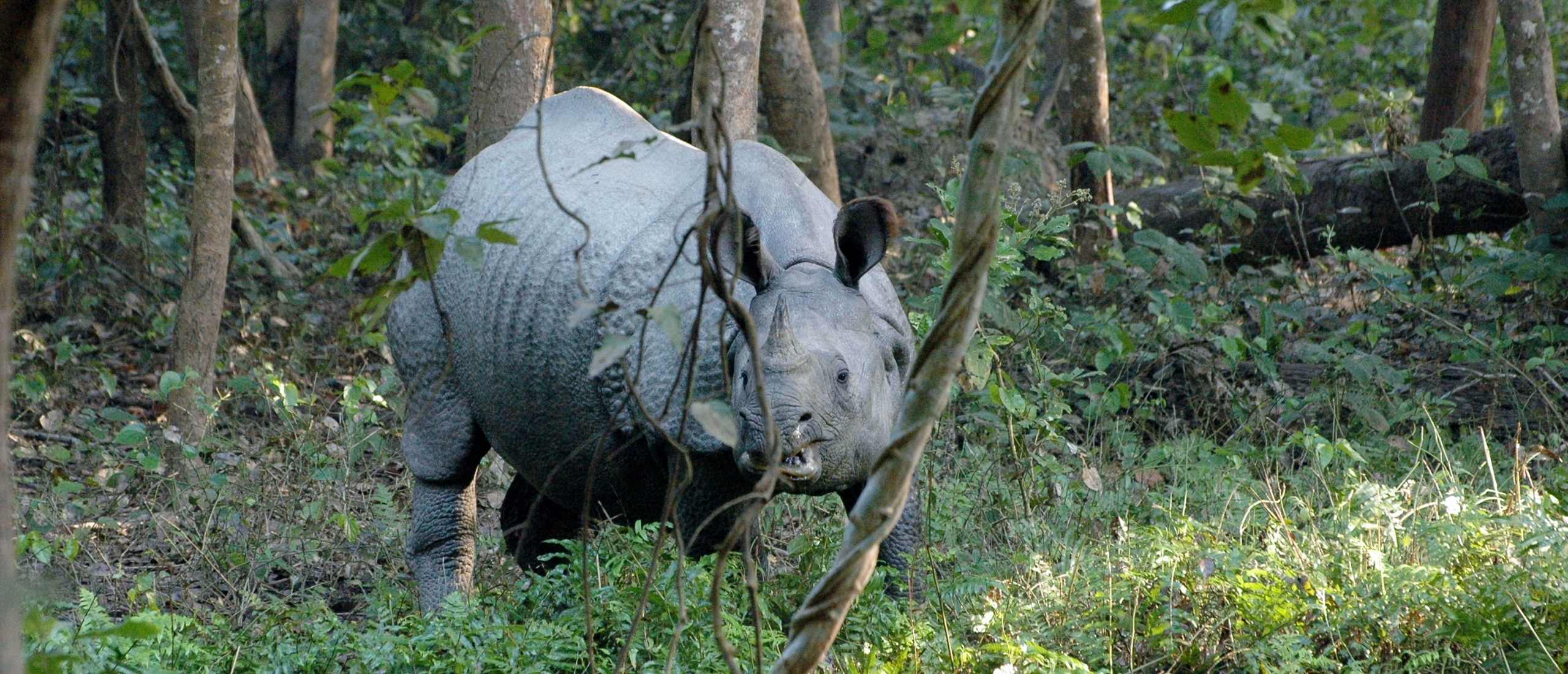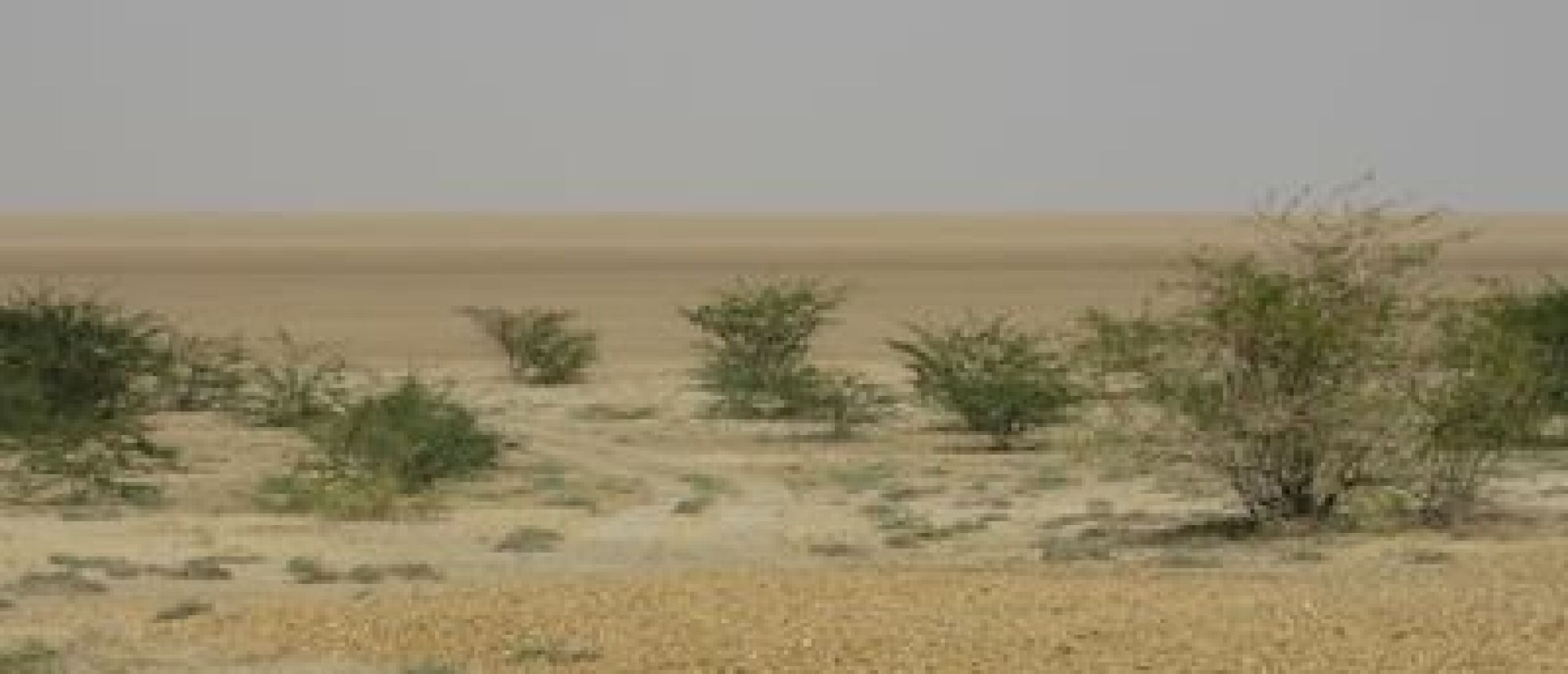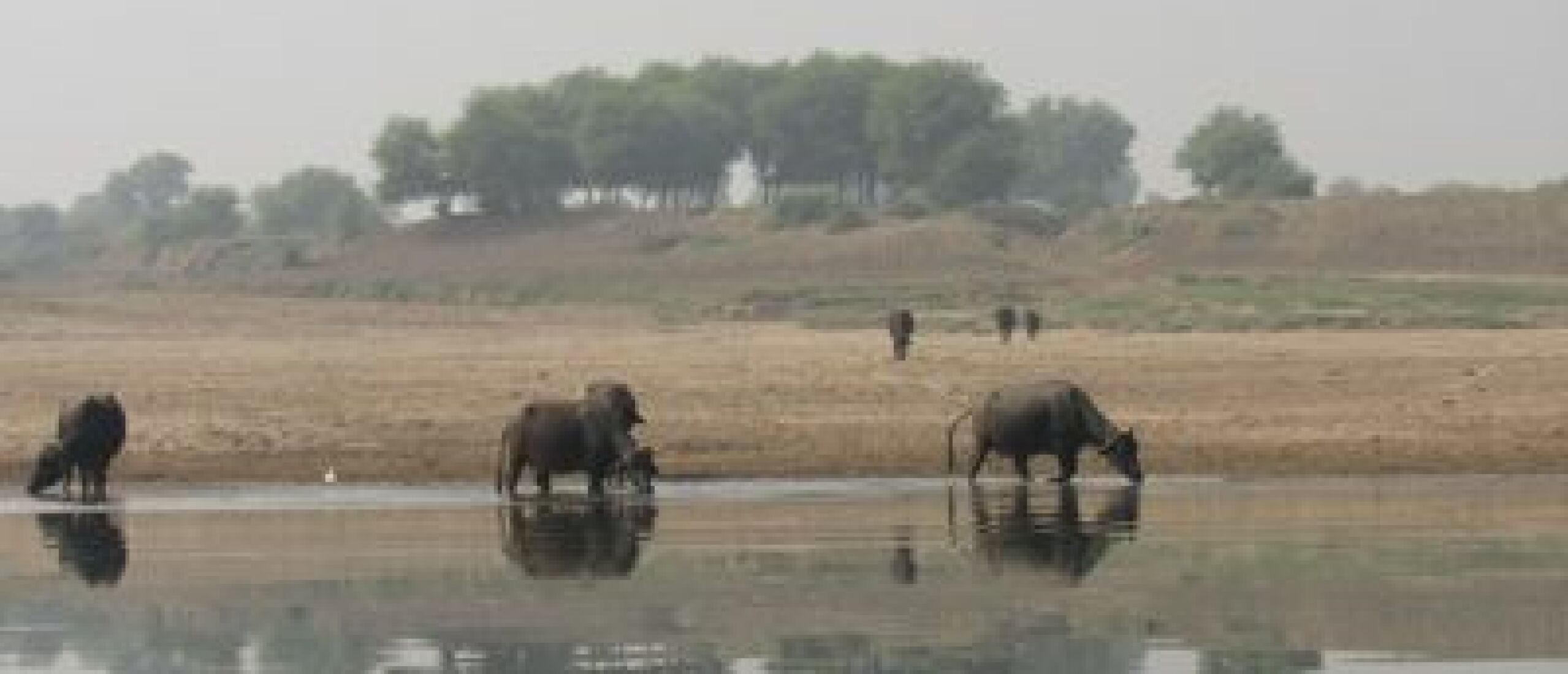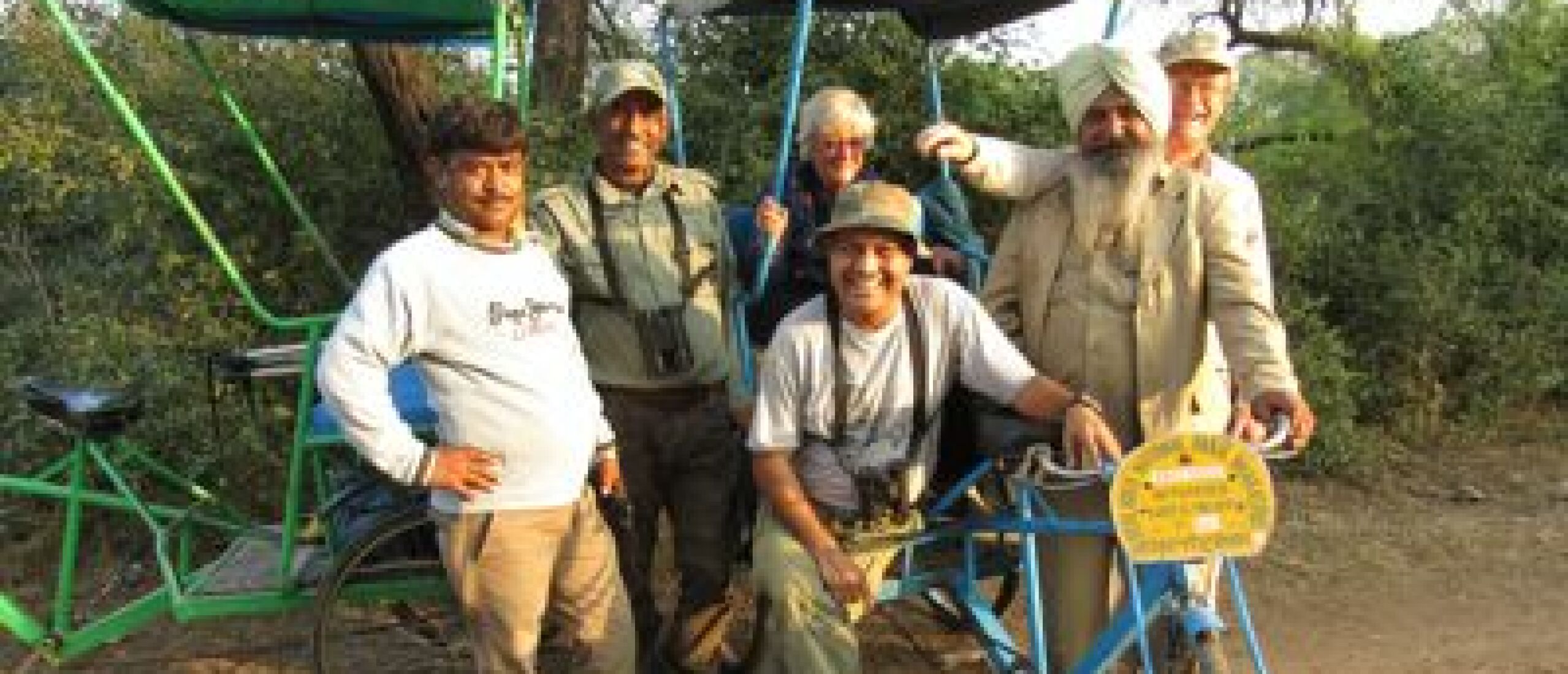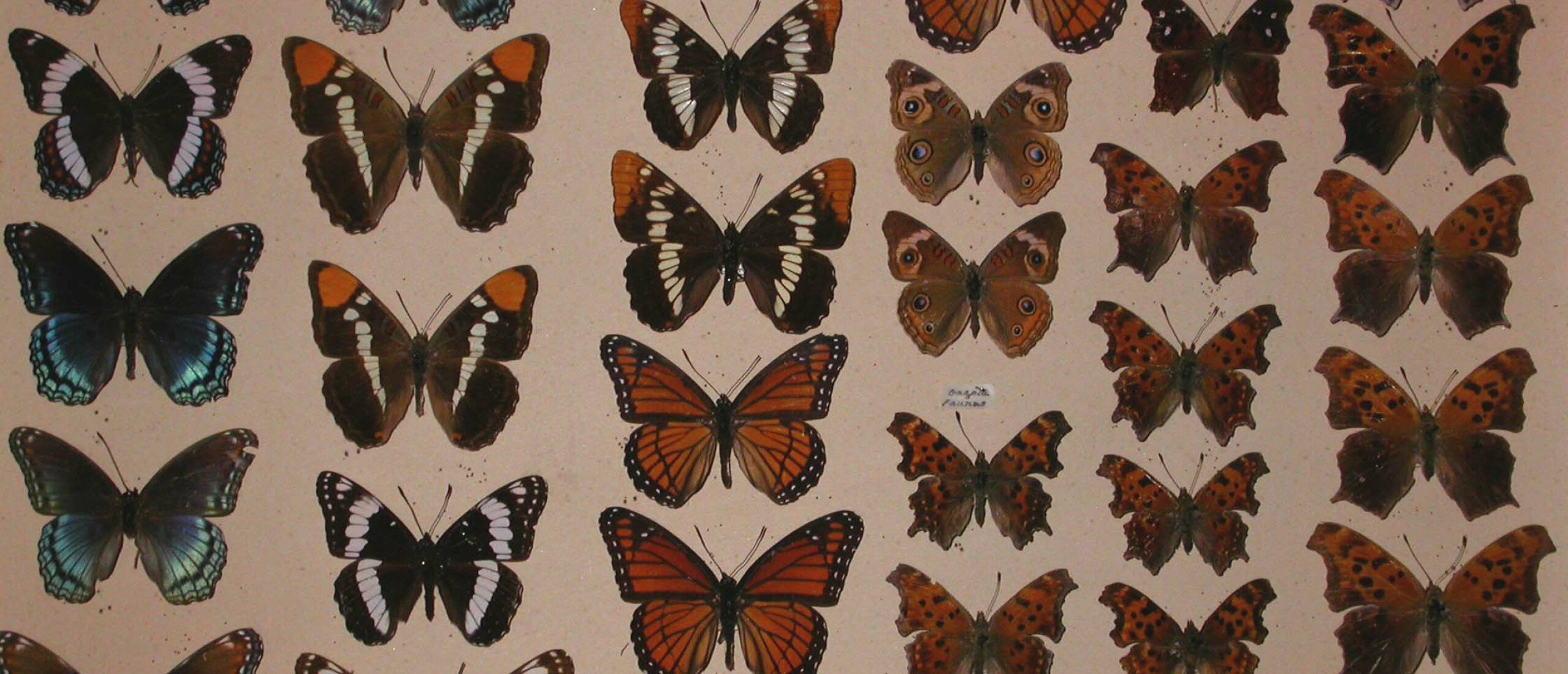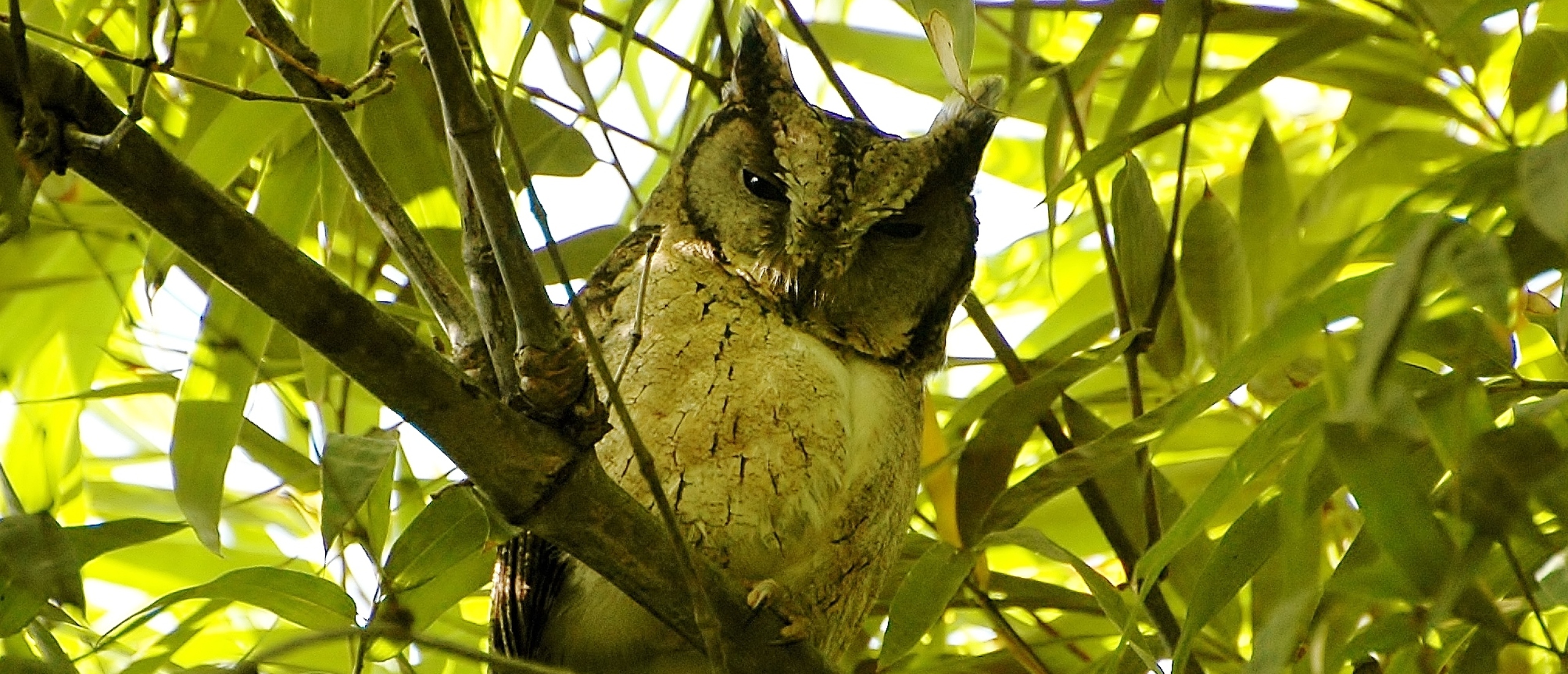
The Tiger and the Gypsies Once I had passed a reasonably comfortable night at the Corbett Tiger Camp, my “Delhi (or rather Dudhwa) Belly" began to stabilize, and I was able to throw myself into the birding again, and on that very morning one of the staff in the Camp, Mickey the Musician (who plays guitar and sings folk songs for the guests by the campfire in the evenings, but who is also an amateur bird enthusiast) pointed out two delightful Collared Scops Owls roosting in a large patch of tall bamboos right by the restaurant. I would never have found them myself, and this is an illustration of just how important local knowledge can be when seeking out particular birds. Even a detailed guidebook is no match, as birds such as owls regularly switch their roosting sites.
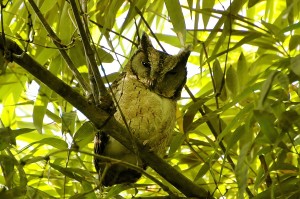 The Collared Scops Owl at its daytime roost site
The Collared Scops Owl at its daytime roost site
The following day our next great adventure began: a three-day stay at Dhikala, the almost iconic accommodation complex that sits in the centre of the Corbett National Park, perched high on a bluff overlooking what had been grassland on both my visits in 1988 and 2006, but this time was a great expanse of water, as on this occasion the Ramganga Reservoir was full, providing a totally different outlook. In 2006 I had been privileged to watch from this point a tiger stalking a herd of spotted deer, which were totally unaware of the big predator’s presence. In the end they ran off, but it was remarkable to see the tiger’s strategy from this marvellous vantage point. This time, almost exactly where this hunt had taken place, a rare gharial, India’s extraordinary fish-eating crocodile, was basking on an islet in the lake. Our experience in Dhikala this time was mixed. The accommodation here is rather dingy and damp, the canteen gloomy (although the service was fine), and why it is necessary to move to a different room each night is beyond me altogether. We did hear rumours that the ultimate plan is to prevent tourists from sleeping here at all, and bring them in on day visits instead. This would, in my view, be a pity, and would greatly increase the traffic on the entrance roads…..but perhaps it might be desirable in one way at least, as Rosemary and I were soon to experience. Dhikala is situated next to an expanse of tall grassland, which is criss-crossed by a number of tracks. At 06.30 each morning, guests congregate near the gate to the electric-fence-enclosed compound, board the Maruti Suzuki Gypsy 4WD vehicles that have replaced Jeeps in India’s national parks, and a convoy of these vehicles heads for this patch of grassland. The Gypsies drive around, drivers and tourists alike scouring the area for the main target species of almost all the visitors: the tiger. When one is spotted, there is a total scrum of revving vehicles, all rushing to gain the best viewing/photographic point, queues form, tourists get frustrated as other tourists block their view, and the tigers look completely disinterested. We did see one tigress this way, but it was worse than viewing the animal in a zoo. Rosemary and I, thinking of the contrast between this sort of tiger-watching and how my grandparents viewed and photographed tigers here in the 1920s and 30s, were appalled, and instructed our driver and guide to go in precisely the opposite direction to all the other vehicles, which they were quite astonished by.
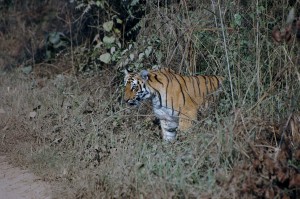 This picture does not reveal what was going on around this tigress
This picture does not reveal what was going on around this tigress
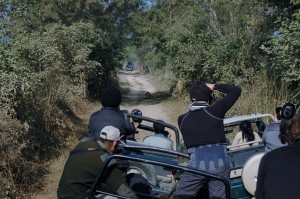 This type of tiger-watching is not my cup of chai
This type of tiger-watching is not my cup of chai
It felt quite satisfying to head off in the opposite direction to all the other Gypsies in the morning mist, and the Sambhar Road was our most frequent destination. This route snakes eastward from the Dhikala complex, running parallel with the Ramganga River, and it was not long before we were treated to a sighting that I had long wished for. A yelping call revealed the presence of not one but six Great Slaty Woodpeckers, Asia’s largest woodpecker species, and one which I had missed on several previous occasions. We were treated to unparalleled views of three of these magnificent birds excavating holes in a great bough of a Sal tree, while the others were calling from nearby – a sight that most certainly deserved a round of biscuits, which I had promised Rehman, our guide, and Faim, our driver, for each new species!
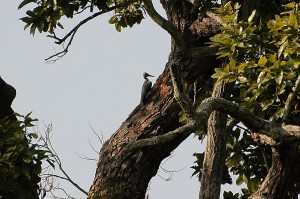 A distant view of one of six Great Slaty Woodpeckers
A distant view of one of six Great Slaty Woodpeckers
One of my great goals is to keep my grandfather F W Champion’s legacy alive, as it was really he, not Jim Corbett, who was the first campaigner for the protection of India’s tigers and other wildlife, at a time when Corbett and others were blasting tigers and leopards to their hearts’ content. Yet in spite of this, the name Corbett is emblazoned on everything you see both in and around the park, with the resorts outside the boundary all being called Corbett this or Corbett that, one even sporting the name Corbett Groove, which conjured up images of the moustachioed Colonel Corbett jiving to some 1920s number. Where is the name Champion to be seen, with even the painted stone marked Champion Road, which leads down to the unmarked Champion’s Pool in the Ramganga river, having disappeared? It is only a few true wildlife/photography/history enthusiasts who now even know of his existence, let alone his extraordinary contribution to India’s wildlife protection movement. Even Geoffrey C and Diane Ward, in their book “Tiger-Wallahs”, which details those campaigners past and present who have dedicated themselves to the protection of the great cat, failed to include someone who, biased though I may be as his grandson, was the most far-sighted and influential Tiger-Wallah of them all. One opportunity I had to keep my grandfather's name alive was a presentation I made at very short notice to the staff and students of the main higher education college in Ramnagar, the town closest to the main entrance of the Corbett National Park, an event that was well attended and which clearly went down well. Unlike my 2006 tour, this journey has been an "unofficial" one, but next time I shall organize many more such talks as part of my effort to enhance public awareness of the extraordinary contributions made by my grandfather to tiger conservation and wildlife photography.
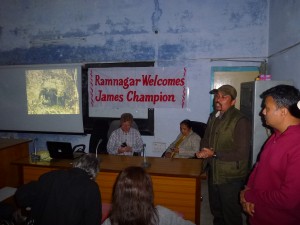 It was a pleasure to talk in Ramnagar about F W Champion's amazing work
It was a pleasure to talk in Ramnagar about F W Champion's amazing work
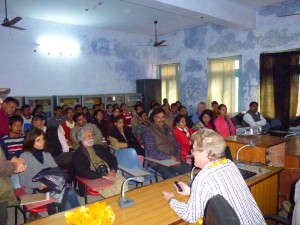 The Ramnagar talk was well attended
The Ramnagar talk was well attended
Once out of the Park, our next destination was Walterre, a delightful resort nestled in a valley between Dehradun and the outermost escarpment of the Himalayan range, upon which perches the old British hill station of Mussoorie. We had visited this spot in 2006 as the guests of one of India’s greatest “Bird-Wallahs”, Bikram Grewal and his wife Alpana, but sadly they were not in residence on this occasion, and we were the only guests. However, we were certainly not bored, as the area provides an astonishing array of ornithological delights, and our evenings were spent in a whirlwind of social engagements with just a few of my friends and former acquaintances from my previous visit in 2006, and there was certainly insufficient time to see them all.
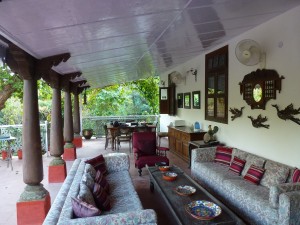 Walterre is well worth a visit
Walterre is well worth a visit
From here we had the honour to be escorted through the western half of the Rajaji National Park by one of my greatest friends from my 2006 visit, Mr S S Rasaily IFS, who has only recently been appointed Director of the Nanda Devi Biosphere Reserve after a spell as Director of Rajaji, so we could hardly have had a better guide to take us through the Park, which is divided into two halves by the Ganges, the populous Hindu pilgrim city of Haridwar, a mainline railway and busy highway, a military ammunition plant and the Chilla Hydo-electric/Irrigation Channel, all of which form a monumental block to the movement of wild animals from Rajaji West to Rajaji East. Our ultimate destination here was the remotely situated Camp Forrest, and it was not until long after dark and following an extremely bumpy ride, during which our usual vehicle, a Toyota Innova (a semi-luxury touring car with a low clearance and totally unsuited to fording deep, stony rivers), nearly became a Toyota Innundated on a number of occasions! Finally, we made it and checked into our tented accommodation, complete with electric heaters and hot-water bottles!
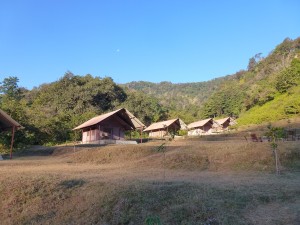 Camp Forrest is a delightful spot
Camp Forrest is a delightful spot
The following morning I was up bright and early, ready for a day’s birding with Viru, my birding guide, and Santeesh (? spelling), my eagle-eyed and very observant driver. To my surprise, Rosemary announced that she was not feeling at her best and would not be joining me. And oh what a mistake that turned out to be for her…following a highly enjoyable day of bumping around the former tiger-photography haunts of my grandfather, who particularly loved this area, known as the Chilla Range, we re-crossed the Ganges and headed back into Rajaji West, and were treated over the space of perhaps 45 minutes to sightings of three of Rosemary’s chief target species of the whole trip, the leopard. Viru and Santeesh consider themselves to leopard-spotting champions, and champions they were on this occasion, and I was delighted to make my first acquaintance with this other great cat, all three of which we spotted along the road in front of us, and the last of which we were able to illuminate in the car headlights and observe for some time before it too slunk away into the darkness.
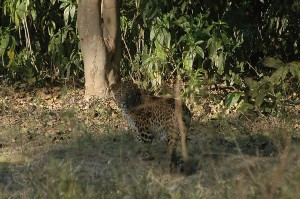 My first wild leopard was a treat indeed
My first wild leopard was a treat indeed
Once back at Camp Forrest, after 14.5 hours on the go but full of excitement, I wondered whether I should even inform Rosemary at all of her misfortune, but of course it slipped out soon enough, and to give her all credit, she took it with dignity! The following day was also to prove highly rewarding, although leopards were nowhere to be seen. Following a morning of bumping around in the Gypsy observing birds and mammals as we went, we headed eastwards to fulfill an appointment with another of my great wildlife friends from my previous visit, Dr Bivash Pandav, of the Wildlife Institute of India (WII), who was hosting a residential Wildlife Management training camp next to Laldhang Forest Rest House, and who was going to show us his remarkable camera-trapping project, using the direct successor of my grandfather’s tripwire photographic system. This work is of great importance in the struggle to protect the tigers, as each animal has its own individual pattern of stripes, and the images obtained by the camera-traps can be used to assess how many tigers remain in a given area. When we arrived, we found that all was far from peaceful in the camp. A tent had burned down in the middle of the night, reducing laptops, cameras and other electronic equipment to blackened, malformed remains. Luckily all four inhabitants of the tent had time to save themselves, as apparently the fire had swept through it in seconds, and they might easily have been asleep as it took place well after midnight. The result of this for us was that Bivash was extremely busy, making inventories of the lost and damaged items, and was therefore unable to take us to see the camera-trap project. However, we were introduced to a colleague of his who was involved in, among projects, a molecular/DNA study that may well, like the camera-trapping, contribute greatly in the struggle to protect endangered species. He has collected a database of DNA samples of tigers from old museum skins, trophies and more recent seized tiger parts, which has allowed him to establish that well over 90% of the genetic diversity of tigers has been lost over the past century. Interesting though that is to know, he has also found that animals and body parts can be traced back to their place of origin by using the same technique. This will allow the authorities to trace illegal wildlife products back to their sources, thereby showing where patrolling efforts should be increased. This idea, coupled with the camera-trapping, should greatly increase the success rate of wildlife crime detection. That evening, just after dark had fallen and as we were bumping back along the track towards Camp Forrest, we were treated to one of those rare wildlife sightings that will remain in the memory for a lifetime. A brownish, moving shape in the fringes of the headlamp beam turned out not to be one but two Brown Fish Owls hopping and running on the ground by a small rivulet. I have seen several Brown Fish Owls sitting motionless at their roosting sites by day, but never had I been able to observe these great birds (Eagle Owl sized) indulging in their night-time behaviour.
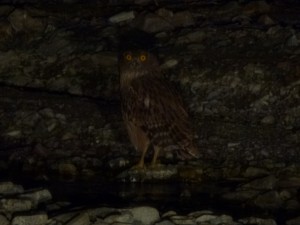 The Brown Fish Owl gave a star performance
The Brown Fish Owl gave a star performance
The following day’s journey took Rosemary and me back to Corbett Tiger Camp for what was to be our last great Indian adventure before our joint tour was due to end. That evening, we were joined by our excellent travel organizer Sumantha Ghosh, of Rural Traveller, and his great friend Chris Mills, of Norfolk Birding, and another British friend of his, Tony. Chris had been leading a tour group in the Corbett area, and he and Tony had stayed on to do a bit of private birding. Much enjoyment was had chatting away by the camp fire, and the following day we all set off in two Gypsies with two excellent local bird guides Jaypee and Nafees on a day drive up towards Ranikhet, and many excellent sightings were made. One of our stops took place at a streambed leading down from the high slopes, where we had extraordinary views of both Little and Spotted Forktails, those delightful black and white denizens of Asian mountain streams. The Spotted is especially spectacular, with its pristine pied plumage and incredibly long tail streamers, as well as its most unusual pure milky white legs and feet. We were treated to a star performance by both birds, but I found myself deeply saddened by the fact that the birds were pecking around among discarded crisp packets and other plastic litter. The plastic trash that disfigures so many wonderful wild parts of India is a problem that I shall be writing more about in the future. I was shocked by it in Guatemala too, and I find it a distressing phenomenon in the UK and even in the squeaky-clean Netherlands, but of all the countries I have visited, India takes the prize for its piles of revolting plastic detritus, which mar so much of its beautiful landscape.
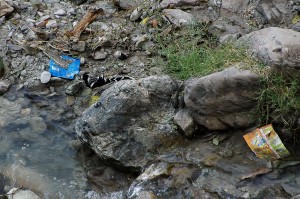 Why do we defile the habitats of such stars as the Spotted Forktail?
Why do we defile the habitats of such stars as the Spotted Forktail?
Beautiful was an adjective that was soon to feature again in our vocabulary, for as we topped the ridge, we were almost swept away in wonder at the snowy panorama of the great Himalaya that appeared along the northern horizon. I have seen this view many times, and indeed it was this view that both Rosemary and my father had cherished so much as a memory from their childhoods in Lansdowne and other hill stations, but the weather now was even clearer than I had yet experienced, and the great peaks were literally glistening in the bright sunlight, a plume of snow blowing off the distant peak of the holy mountain Trisul. It was almost as if the gods were rewarding Rosemary for the effort she had made to return to the land of her birth at the age of 84, and providing a worthy compensation for the fact that we had failed in our attempts to gain permission to visit the closed military cantonment of (relatively) nearby Lansdowne, where we had hoped to visit the homes in which my father had been born in 1928, and she in 1930.
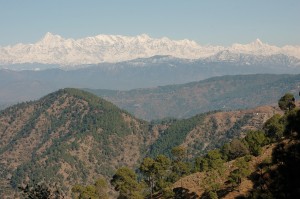 The Himalayan view was particularly spectacular
The Himalayan view was particularly spectacular
 Trisul was especially clear in the crisp mountain air
Trisul was especially clear in the crisp mountain air
Our last day involved a long journey from Ramnagar to Delhi, driven by our former driver “Puppy”, who despite not having binoculars or a bird book was turning out to be a promising bird spotter and guide himself, for he stopped at various points along the route, pointing out some interesting birds, including a pair of the stately and endangered Sarus Crane, feeding peacefully in a wetland area next to the busy road.
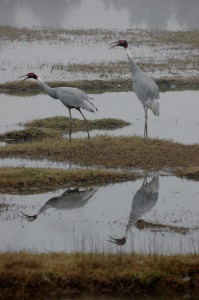 Sarus Cranes are among the most elegant of birds
Sarus Cranes are among the most elegant of birds
And so ended our journey together. I flew down to Cochin to start a two-week tour of South India, seeking out the endemic species of the Western Ghats and the Nilgiri Hills, and she flew out a couple of days later, bound for the UK, where she was to spend Christmas with her 89-year-old sister, recounting the tales of our Great Indian Adventure, before eventually returning to a foot or so of snow in her hometown in the wilds of British Columbia. What a trip it has been!
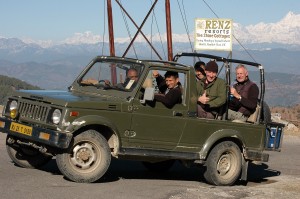 The Norfolk Birding and Rural Traveller teams in a Gypsy in front of the Himalayan panorama
The Norfolk Birding and Rural Traveller teams in a Gypsy in front of the Himalayan panorama


